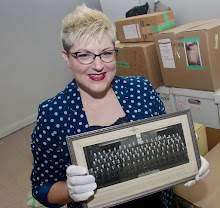People ask me about Passover. I loathe explaining it, because I'm always afraid of my own ignorance, however; I did a good job in an email to Rick when he asked about the Seder. He also did a bit of research and I'll post that here, too.
From my email: The Seder is the Passover supper (there are three: two on the first two nights and one on the last, but reformed Jews usually only do the first, and sometimes the second).
Through the eating of specific foods, we commemorate the suffering and blessings that our ancestors survived in their flight from Egypt. Passover itself is refering to the final plague set upon the Egyptians... the killing of the first born son. Jews marked their doors with lamb blood to signify their faith and so, the Angel of Death passed over their houses.
In Christian terms, the Seder is what Jesus celebrated with his disciples when they had the Last Supper.
From the website, detailing what is set upon the Seder plate:
Maror
Bitter Herbs (usually horseradish) symbolize the bitterness of Egyptian slavery
Karpas
Vegetable (usually parsley) is dipped into salt water during the seder. The salt water represents the tears shed during Egyptian slavery.
Chazeret
Bitter Vegetable (often lettuce) is often used in addition to the maror as a bitter herb
Charoset
Apple, nuts, and spices ground together and mixed with wine are symbolic of the mortar used by Hebrew slaves to build Egyptian structures
Zeroa
The Shankbone is symbolic of the Paschal lamb offered as the Passover sacrifice in biblical times
Beitzah
The Roasted Egg is symbolic of the festival sacrifice made in biblical times
I hope that enlightens a few.
A little piece of my mind, for what it's worth
About Me

- MiRSCH
- Museum professional, PhD student, adventurer, cat-mom, day-dreamer. Working hard at all four. Bad at math.
Recent deviations
MiniMeanderings
Some Favourite Reading
- 1984 - Orwell
- Box of Delights, The - Masefield
- Chronicles of Narnia, The - Lewis
- Frankenstein - Shelley
- Good Omens - Pratchett/Gaiman
- Great Expectations - Dickens
- Mirror of the Artist, The - Harbison
- Neuromancer - Gibson
- Phantom Tollbooth, The - Juster
- Tennant of Wildfell Hall, The - Bronte, A.
Blog Archive
- October 2001 (14)
- November 2001 (27)
- December 2001 (16)
- January 2002 (29)
- February 2002 (17)
- March 2002 (18)
- April 2002 (21)
- May 2002 (26)
- June 2002 (16)
- July 2002 (9)
- August 2002 (13)
- September 2002 (12)
- October 2002 (18)
- November 2002 (12)
- December 2002 (13)
- January 2003 (13)
- February 2003 (12)
- March 2003 (13)
- April 2003 (13)
- May 2003 (20)
- June 2003 (9)
- July 2003 (16)
- August 2003 (15)
- September 2003 (15)
- October 2003 (11)
- November 2003 (14)
- December 2003 (14)
- January 2004 (12)
- February 2004 (9)
- March 2004 (8)
- April 2004 (8)
- May 2004 (6)
- June 2004 (8)
- July 2004 (7)
- August 2004 (5)
- September 2004 (7)
- October 2004 (6)
- November 2004 (5)
- December 2004 (10)
- January 2005 (6)
- February 2005 (7)
- March 2005 (6)
- April 2005 (9)
- May 2005 (6)
- June 2005 (6)
- July 2005 (3)
- August 2005 (6)
- September 2005 (3)
- October 2005 (5)
- November 2005 (2)
- December 2005 (7)
- January 2006 (1)
- February 2006 (3)
- March 2006 (6)
- April 2006 (2)
- May 2006 (7)
- June 2006 (3)
- July 2006 (3)
- August 2006 (1)
- September 2006 (3)
- October 2006 (3)
- November 2006 (3)
- December 2006 (2)
- January 2007 (2)
- March 2007 (1)
- April 2007 (1)
- May 2007 (3)
- July 2007 (47)
- August 2007 (3)
- September 2007 (4)
- October 2007 (4)
- June 2008 (2)
- August 2008 (2)
- September 2008 (2)
- November 2008 (1)
- December 2008 (1)
- February 2009 (1)
- March 2009 (2)
- April 2009 (1)
- August 2009 (1)
- March 2010 (1)
- July 2010 (1)
- September 2010 (1)
- November 2010 (1)
- June 2011 (1)
- July 2011 (1)
- September 2011 (1)
- October 2011 (3)
- November 2011 (2)
- July 2012 (1)